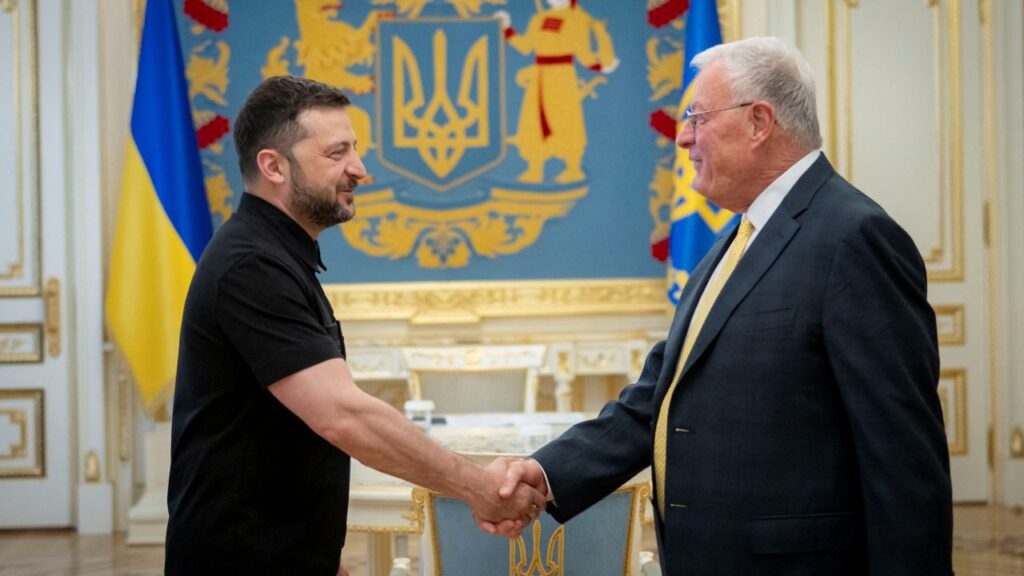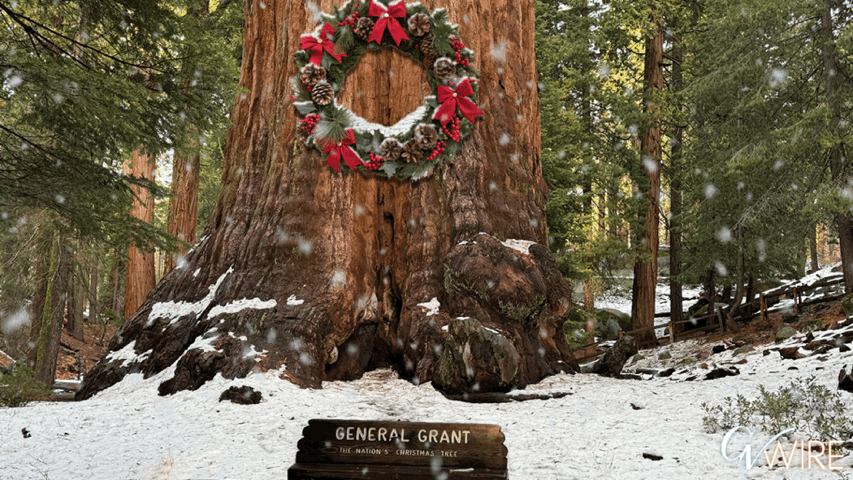Share
Planes spread out across the sky, nearly wingtip to wingtip. A sniper’s bullet whizzing by the ear. Squeezing a dying soldier’s hand, so he knew he was not alone.
Across three quarters of a century, the old veterans remember that epic day on the beaches of Normandy. For historians, D-Day was a turning point in the war against Germany; for men who were among the 160,000 Allied fighters who mounted history’s largest amphibious invasion, June 6, 1944, remains a kaleidoscope of memories, a signal moment of their youth.
Not many of those brave men remain, and those that do often use canes, walkers or wheelchairs. Few are willing or able to return to Normandy for the anniversary. But listen to the stories of some who are making that sentimental journey that spans thousands of miles — and 75 years.
Paratrooper Joined the Canadian Military at 17
The day before Dennis Trudeau parachuted into Normandy, he wrote his parents a letter saying he was about to go into battle but they shouldn’t worry.
“Everything is going to be fine and dandy,” he wrote. “After all, I’m not scared.”
Trudeau had joined the Canadian military at 17 and became a paratrooper, in part because they were paid an extra $50 a month.
He’s 93 now, living in Grovetown, Georgia. But his memories of D-Day — and the day before D-Day — are undimmed.
On June 5, 1944, he and the other paratroopers sat on the tarmac and joked about how they’d be in Paris by Christmas. But when they climbed into the plane, the chatter stopped.
Trudeau’s position was by the open jump door; he could look out across the vast array of planes and ships powering toward Normandy. Planes were strung out across the horizon.
He prayed: “I just kind of told the Lord, ‘Let me see one more sunrise.'”
And then, he jumped.
Trudeau landed in water up to his waist in a flooded field. In the dark, he rendezvoused with other paratroopers. They were on the way to their objective when friendly fire hit — an Air Force bomb.
Thrown into a ditch, Trudeau heard a dying friend nearby, calling out for his mother.
“You train with him and you ate with him and you slept with him and you fought with him. And in less than three hours, he was gone,” he said.
Within hours, combat would be over for Trudeau, as well. He was captured by German forces, and spent the duration in a prisoner-of-war camp. By the time the war was over he had gone from 135 pounds to about 85.
He returned to Normandy in 1955 to see the graves of eight platoon members who didn’t survive. This time, he’ll say a prayer over their graves.
“They’re the heroes. They’re the ones who gave everything they had,” he said.
He Went on to Fight Through the Hedgerows of Normandy
There had been a number of false starts ahead of the invasion of Normandy. But Vincent Corsini knew June 6 was different. There was a certain feeling in the air — an “edge,” as he describes it. Chaplains on deck encouraged troops to pray and troops were given a good breakfast.
Certain other D-Day memories are crystal clear: peeking out over the edge of the landing craft with amazement at the U.S. firepower directed at the beach. Machine guns splattering the water as he unloaded. The weight of the 60mm mortars he carried.
Tucked against the bottom of the hill overlooking Omaha Beach, he heard someone yelling for help from the water. Taking off as much equipment as he could, he ran back to the waves and found a stranded officer.
“As I was standing there looking at him, somebody up on the hill pulled the trigger,” he said. The bullet narrowly missed his ear, feeling like a “sonic boom,” as it passed. Corsini grabbed the officer and pulled him to safety.
Corsini went on to fight through the dense hedgerows of Normandy with the 29th Infantry Division until they captured the strategic city of Saint-Lo. At his home in a retirement community in Burlington, North Carolina, a plaque on the wall — “D-Day to St. Lo” — commemorates his efforts. Another marks his receipt of the National Order of the Legion of Honor, France’s highest decoration.
He went back for the 50th D-Day anniversary and looked across a cemetery’s field of white crosses. His wife and members of the French Club he meets with monthly encouraged him to go on the 75th anniversary, at age 94.
His wartime experiences affected his life forever, he said.
“I wouldn’t change my experience for a million dollars,” he said, adding: “I wouldn’t go through it again for a million dollars.”

On D-Day, He Pulled Bodies From the Choppy Seas
Frank DeVita remembers the moment he froze.
He had wanted to join the Air Force but had no peripheral vision. He wanted to join the Navy but it would take weeks to start basic training. That’s how he ended up in the Coast Guard on D-Day, ferrying troops to Omaha Beach.
His job was to lower the ramp when the craft got to shore and then raise it after the troops clamored out. But in the early morning hours, as machine gun fire rained down on the boat, that ramp served as DeVita’s shield, protecting him and the other men inside. The coxswain screamed at him to lower the ramp, and in the roar of the cannons and the craft’s diesel engines, DeVita couldn’t hear him. The coxswain screamed again.
“I froze. I was so scared because I knew when I dropped that ramp the bullets that were hitting the ramp were going to come into the boat and I’d probably be dead in five minutes,” said DeVita, 94, speaking from his home in Bridgewater, New Jersey. When he finally dropped the ramp, he said 14 or 15 troops were immediately raked by machine gun fire.
One soldier fell at his feet, his red hair full of blood: “I reached down and I touched his hand, because I wanted him to know he wasn’t alone.”
Then, when he tried to lift the ramp, it was stuck. DeVita had to crawl over dead bodies lining the bottom of the landing craft to fix it.
Again and again, the landing craft ferried men to the beach. When there were no more men to ferry, DeVita and the other sailors pulled bodies from the choppy seas.
For decades — until recently — he never spoke of these things. This June he’ll make his 12th trip back to Normandy. Eager to keep the memory of what happened there alive, he has often brought others along to places like the American cemetery at Colleville-sur-Mer.
“Pick out a tombstone, any tombstone. Place your hand on that white marble and say to yourself, ‘Six feet down is a boy.’ …. He gave his life for his country and then you lift your eyes up and you see 9,400 white marble tombstones,” he said. “They all gave their lives for their country.”

After the War, Solider Went Back to France and Europe Several Times
At 93, Norman Harold Kirby looks back at D-Day and the months of fighting that followed and finds it hard to remember exactly what happened.
“A lot of it, I tried to forget,” he said.
The Canadian, who now lives in Lions Bay, British Columbia, had joined the army when he was only 17 and was barely a 19-year-old private when he climbed into the landing craft that would take him to shore. The landing craft hit a mine, blowing a hole in the ship. His ears ringing from the explosion, Kirby abandoned the heavy gear he was carrying, his Bren machine gun and ammunition, and climbed over the side. Many who couldn’t swim died in the water.
“I landed on the on the beach with my knife, fork and spoon,” he said.
On Juno Beach, he remembers an intense cacophony of sounds. Aircraft flying overhead. Navy shells rocketing toward the German positions.
“The noise was just unreal…You couldn’t hear anything, anybody talking or anything. People were yelling,” he said. “You couldn’t hear them because of all the racket going on.”
Kirby went back to France and Europe several times after the war as a tourist but for years never returned to Juno Beach.
“I would not go to the beach. I always stayed away from it. I didn’t want to go,” he said. Finally his wife sent him on a trip to Normandy for the 50th anniversary of the invasion. This time, she’ll accompany him to the 75th anniversary.

The 19-Year-Old Paratrooper Didn’t Know What to Expect
Climbing into the plane that would take him to Normandy, Eugene Deibler had no idea what to expect. The 19-year-old had joined the paratroopers to avoid being a radio operator, trained for months and survived a broken ankle in jump school, but had yet to see combat.
Gathered at Merryfield Airfield in southwest England, the paratroopers had already gotten geared up to jump the night before, and then the operation was called off due to bad weather. All that pent-up energy had to go someplace, and Deibler remembers troops getting into fights.
The second night, it was a go. Climbing into the plane, Deibler remembers telling himself that if his buddies could do this, so could he.
“If you weren’t scared something was wrong with you,” he said. “Because you’re just a kid, you know?”
As they arrived at the French coast, he remembers heavy antiaircraft fire and tracer bullets from machine guns lighting up the sky like fireworks.
“We said ‘Let’s get the hell out of this plane,'” he said. The jump light went on, and out they went.
On the ground, their job was to secure a series of locks on the Douve River to prevent the Germans from opening the locks and flooding the fields. But they ran into such fierce resistance trying to secure another objective — a set of bridges — that they had to fall back.
Deibler went on to fight across Normandy, Holland and Belgium, in the Battle of Bastogne.
This will be his first time back to Normandy since the invasion, and he’d like to see what’s changed. At his Charlotte, North Carolina, home, the 94-year-old retired dentist has a collection of World War II books. He’s afraid that the great conflict will be forgotten.
“How many people remember the Civil War? How many people will remember World War I? And now it’s the same with World War II,” he said. “World War II will fade away also.”

Solider Fought His Way Across Europe
Of all the medals and awards that Steve Melnikoff received as a 23-year-old fighting his way across Europe, the Combat Infantry Badge means the most to him. It signifies the bearer “had intimate contact with the enemy,” he said.
And Melnikoff certainly did.
When he landed on Omaha Beach on D-Day-plus-1 — June 7, 1944 — victory was far from secure. His unit was part of the bloody campaign to capture the French town of Saint-Lo through fields marked by thick hedgerows that provided perfect cover for German troops.
He remembers the battle for Hill 108 — dubbed Purple Heart Hill — for its ferocity. His job was to take up the Browning Automatic Rifle should the man wielding it go down. The Germans had shot and killed his friend who was carrying the BAR, and Melnikoff picked it up. About an hour later, he too was shot. As he went down, he looked to the side and saw his lieutenant also come under fire.
“He’s being hit by the same automatic fire, just standing there taking all these hits. And when the machine gun stopped firing he just hit the ground. He was gone,” Melnikoff said.
“That is what happens in war,” he said, speaking from his Cockeysville, Maryland, home.
For decades he didn’t talk about the war and knows some men who went to their graves never speaking about it again. But he feels an obligation now to talk about what he and others went through. In his hundredth year, he works closely with The Greatest Generations Foundation, which helps veterans return to battlefields where they fought. This year on June 6, he’ll go back to the cemetery and pay his respects.
“This prosperity and peace that we’ve had for all these years, it’s because of that generation,” he said. “It can’t happen again and that’s why I go there.”




















